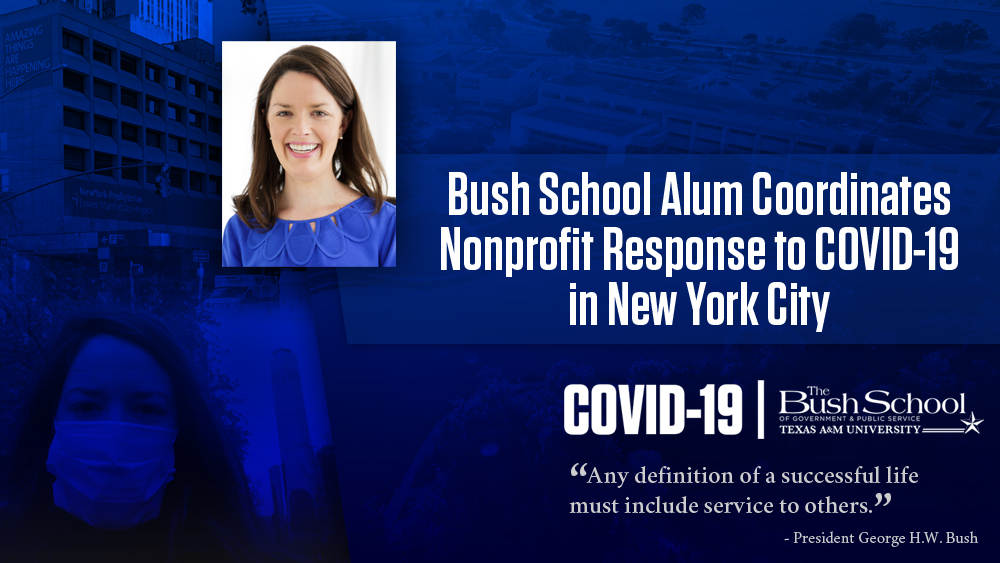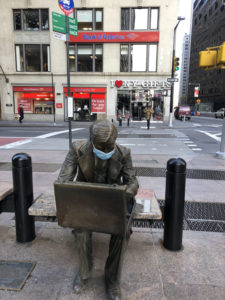
By Justin Bailey
At 7 PM on a “normal” night in New York City, it’s easy to get lost in the “hustle and bustle” of America’s largest and most dense metropolitan area. People commute home from work after a long day or catch the subway to see a movie with friends. Esther Larson, a 2006 Master of Public Service and Administration graduate, would usually be among them.
In April of 2020, an entirely new and surreal scene unfolds. Every night at 7 PM, Larson’s apartment window opens wide, in unison with thousands of others across the city, and cheers and applause echo through the skyscrapers—a heart-felt “thank you” to the city’s beleaguered health care providers.
Thinking back, the Bush School prepared me for working under tremendous pressure. I remember times during my capstone project that taught me how to work collaboratively with a team to get the job done.
– Esther Larson
Her role as Director of Programs for Hope for New York has thrust her into the middle of not only the worst pandemic in a century but also one of the largest mobilizations of nonprofit organizations in the city’s history.
“During normal times, our team is responsible for implementing a three-pronged model: grant funding, volunteer mobilization, and network and capacity building,” Larson explained.
“I direct and work with my team to oversee our annual $2+ million in direct grant funding to support programs. I direct volunteer engagement with our affiliate partners and develop the strategies that help our partners fulfill their missions.”
Addressing the Pandemic
As the virus swept through the city and the severity of the situation set in, Larson began to realize the important role Hope for New York would play in helping the city through the crisis.
“I started ‘sheltering in place’ and working remotely very early on,” Larson said. “At first, the city seemed somewhat like it was slowing down, but schools were still in session, and everyone was figuring out what to do, including my organization and the organizations we partner with.”

In mid-March, as confirmed cases of COVID-19 began to skyrocket and New York City was labeled “an epicenter,” the importance of providing money for organizations doing the vital work on the ground became apparent. Larson says that being able not only to provide that but also to help organizations apply for grants has been one of the most important ways she and Hope for New York have been able to help.
“One of the most impactful things we’ve done so far has been opening up relief grants for our affiliates, which help them cover both programmatic and organizational costs,” Larson said. “It’s critical that they have access to the resources they need not just from us but from federal and private grants. The work they’re doing is too important for them to have to dedicate a huge amount of time to looking for funds.”
Larson has also worked to provide volunteers to partner organizations in dire need of manpower. One such mobilization, sending volunteers to help set up the “pop-up” hospital in Central Park, was one of the more surreal moments for Larson in a month full of them.
“We had a lot of Hope for New York volunteers go out to Central Park for that,” Larson said. “It was incredibly heart-warming to see the way the community supported that but also a very sobering realization that our city had come to this—an extension hospital in Central Park. It’s unbelievable.”
Moments of realization like that can leave even the most battle-tested leaders feeling overwhelmed. In part, Larson credits her time at the Bush School for preparing her for the pressure she’s working under now.
Working under Pressure
“It’s extremely intense,” Larson confessed. “I have my moments of extreme peace, knowing that this calling is an incredible blessing. Other moments, I’m panicking and wondering if I should have left New York when I could.”
“Thinking back, the Bush School prepared me for working under tremendous pressure. I remember times during my capstone project that taught me how to work collaboratively with a team to get the job done; how to be resilient and have perseverance in the hard times or with limited resources; how to lean on team members and fellow students, faculty, and staff.”
Larson also sees value in her time as the Chair of the Bush School’s Public Service Organization, which works intensely with nonprofits in the Bryan/College Station area.
“We partnered with nonprofits, mobilized volunteers and resources, and sought to better the nonprofit sector in the community,” Larson explained. “That’s exactly what I’m doing now—just on a larger scale and in a different context.”
In moments when she feels overwhelmed, Larson makes a point to “count her blessings” and remember why her job is important.
“Through all of this, I try to remember the many privileges I have,” Larson said. “I have shelter to “shelter in place”; food and clothing and a shower; family, friends, and a church community to support me. There are so many people that don’t have these blessings.”
“I do what I’m doing at Hope for New York to help those who are vulnerable, isolated, and alone—those who don’t have resources or a support network. This work is a noble calling because it’s not about me. It’s about others and serving in whatever way I can.”
